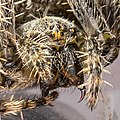| Araneus diadematus | |
|---|---|

| |
| Female | |

| |
| Male | |
| Scientific classification | |
| Domain: | Eukaryota |
| Kingdom: | Animalia |
| Phylum: | Arthropoda |
| Subphylum: | Chelicerata |
| Class: | Arachnida |
| Order: | Araneae |
| Infraorder: | Araneomorphae |
| Family: | Araneidae |
| Genus: | Araneus |
| Species: | A. diadematus |
| Binomial name | |
| Araneus diadematus Clerck, 1757 | |

The spider species Araneus diadematus is commonly called the European garden spider, cross orbweaver, diadem spider, orangie, cross spider, and crowned orb weaver. It is sometimes called the pumpkin spider, although this name is also used for a different species, Araneus marmoreus. It is an orb-weaver spider found in Europe, where it is native, and North America, where it was introduced.
Range
A. diadematus has a holarctic distribution throughout Europe and across North America, from southern Canada to Mexico, and from British Columbia to Newfoundland.
Size and markings

Individual spiders' colourings can range from extremely light yellow to very dark grey, but all A. diadematus spiders have mottled white markings across the dorsal abdomen, with four or more segments forming a cross. The markings are formed in cells filled with guanine, which is a byproduct of protein metabolism.
Adult females range in length from 6.5 to 20 mm (0.26 to 0.79 in), while males range from 5.5 to 13 mm (0.22 to 0.51 in). Occasionally, the female will eat the male directly after mating. (See video below.)
Specialization
| This section needs additional citations for verification. Please help improve this article by adding citations to reliable sources in this section. Unsourced material may be challenged and removed. Find sources: "Araneus diadematus" – news · newspapers · books · scholar · JSTOR (November 2018) (Learn how and when to remove this message) |
The legs of orb-weaver spiders are specialized for spinning orb webs. The webs are built by the larger females, which hang head down in the center of the web or remain hidden in nearby foliage, with one claw hooked to a signal line connected to the main orb, waiting for a disturbance to signal the arrival of prey. Prey is then quickly wrapped in silk and bitten, and the prey may hang on the web to be stored for later consumption. The initial bite serves to paralyze the prey and minimize the danger of the spider herself being stung or bitten, and the enzymes thus injected serve to begin liquefaction of the prey's internal structures.
Alongside the use of the web to capture other prey, the spiders are also cannibals and prey on each other, but this only happens just before, during, or just after sexual activity. They attack based on their size, sexual experience, and hunger levels.
A. diadematus is a reclusive creature and only bites humans if cornered or otherwise provoked. It responds to a disturbance by vibrating rapidly in its web until it becomes a blur, a reaction that is assumed to confuse potential predators.
Gallery
-
 Araneus diadematus - tunisia
Araneus diadematus - tunisia
-
 On its web, showing the markings on its abdomen
On its web, showing the markings on its abdomen
-
 Spiderlings in an orb web
Spiderlings in an orb web
-
 Spiderling cluster
Spiderling cluster
-
 Ventral view, female
Ventral view, female
-
 Facial detail, female
Facial detail, female
-
 European garden spider on banana plant
European garden spider on banana plant
-
 European garden spiders were the first spiders in space, aboard Skylab 3.
European garden spiders were the first spiders in space, aboard Skylab 3.
- Courting male is consumed by the female. (video, 1m 38s)
References
- "Taxon details Araneus diadematus Clerck, 1757", World Spider Catalog, Natural History Museum Bern, retrieved 2023-01-19
- Hawkes, Alison (31 October 2012), "Signs of the Season: Pumpkin spiders on the move", Bay Nature, retrieved 2017-11-12
- "Species Araneus marmoreus - Marbled Orbweaver", BugGuide, retrieved 2017-11-12
- Cross Orbweaver; at BugGuide online; retrieved April 2013
- Cross Spider, Washington NatureMapping Project
- Rainer F. Foelix (1992). Biologie der Spinnen [Biology of the Spiders] (in German). Stuttgart: Thieme. ISBN 978-3-13-575802-2.
- Cross Orbweaver, Penn State Entomology
- Farr-Cox, Francis; Oxford, Geoff & Smith, Helen (2018). Factsheet 4 Garden spider (Araneus diadematus). British Arachnological Society. Archived from the original (PDF) on 2020-02-07. Retrieved 2020-02-07.
External links
- European orb-weavers
- Roggenbuck, Helma; Pekár, Stano; Schneider, Jutta M. (April 2011). "Sexual cannibalism in the European garden spider Araneus diadematus: the roles of female hunger and mate size dimorphism". Animal Behaviour. 81 (4): 749–755. doi:10.1016/j.anbehav.2011.01.005. S2CID 54240443.